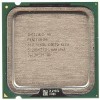Intel 640 User Guide - Page 56
Temperature to begin Fan Acceleration
 |
UPC - 683728178901
View all Intel 640 manuals
Add to My Manuals
Save this manual to your list of manuals |
Page 56 highlights
Acoustic Fan Speed Control Figure 18. Fan Speed Control Full Speed R 100 % Fan Speed (RPM) Fan Speed (% PWM Duty Cycle) Min Speed X % TLOW TCONTROL Diode Temperature (°C) 6.3.1.1 Temperature to begin Fan Acceleration The first item to consider is the value for TLOW. The FSC device needs a minimum temperature to set as the threshold to begin increasing PWM duty cycle to the fan. The system designer might initially consider a small temperature range (TCONTROL - TLOW = TRANGE), such as 5 °C to accelerate the fan. That would delay the fan accelerating for the longest period after an increase in TDIODE. There are a number of issues that should be considered with this strategy: • There is little granularity in the fan speeds. For each 1 °C of increase in diode temperature = 20% jump in PWM duty cycle %. • Fan speed oscillation as the thermal solution chases the diode temperature. • Having TDIODE overshoot TCONTROL and the thermal profile causing the Thermal Control Circuit to activate to reduce the temperature. The first two cases can create a poor acoustic response for the user. For the third case, the user could notice a drop in performance as the thermal control circuit reduces the power. Figure 19 is an example of this situation. The system begins at idle and a moderate workload is applied (less than TDP). 56 Thermal/Mechanical Design Guide















